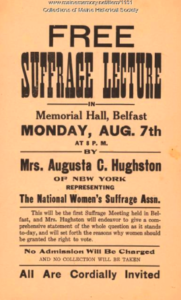Did you know that the daffodil was the symbol for Maine suffragists during their fight for the right to vote? That right was secured in 1920 with the ratification of the Nineteenth Amendment to the US Constitution.
Here at the Gannett House, we have a historical connection to the Maine suffragette movement. Anne Gannett, the wife of Guy P Gannett and former resident of the house that is now the First Amendment Museum, was a leader of the suffrage movement in Augusta, Maine.

Free Speech
During Anne’s time, it was considered shocking for a woman to speak to mixed-gender crowds in public. Conventions featuring female speakers were attacked by mobs, and Susan B. Anthony herself said, “No advanced step taken by women has been so bitterly contested as that of speaking in public.” Opponents were afraid of women spreading their radical ideas about the right to vote, or suffrage. As many of the founders of the suffrage movement had also been involved in the abolition and temperance movement, they understood the importance of speaking as a group in order to advance their cause. Image: Suffrage lecture announcement, Belfast, ca. 1915, from Maine Historical Society
Interestingly enough, the suffrage movement propelled other women – even women who were fundamentally opposed to women’s involvement in politics – into politics. These women were known as “Antis”, and Anne Gannett’s mother-in-law, Sadie Gannett, was one. Despite their belief that women would be corrupted by politics, Antis organized as much as Suffragists did by producing and distributing anti-suffrage pamphlets, letters, and slogans.
Guy Gannett, who was a member of the Maine legislature at the time, found himself caught in the middle – with a Suffragist wife and an Anti mother. He famously wore a daffodil, symbol of the Suffragists, on one lapel and a red rose, symbol of the Antis, on the other.

Free Press?
Despite the free press being a cornerstone of American democracy, many contemporary mainstream papers trivialized, ridiculed, or ignored the suffragist movement.
And while Comfort Magazine, William Gannett’s publication, featured women writers, their articles focused exclusively on domestic topics and not the suffrage movement.
Image: excerpt from Comfort Magazine, December 1919
Using the Right to Petition
Through the abolitionist and temperance movements, women learned about the power of gathering signatures and submitting petitions. They used these same tactics in the suffrage movement. At the time, no one expected the government to take real action, so petitions were used as a way to build consensus and reflect on the will of the people.
Image: a 1917 petition signed by 1233 Bangor residents in favor of the suffrage referendum

Arrested for Assembly
8,000 suffragists descended on Washington, D.C. the day before Woodrow Wilson’s inauguration in 1913 to advocate for suffrage. In fact, suffragists were the first group to protest outside the White House. Suffragists burned an effigy of President Wilson and copies of his speeches in front of the White House and were promptly arrested. While in jail, some suffragists began a hunger strike.
Wilson, aware of both the negative press and the growing political strength of the movement, publicly endorsed women’s suffrage in his second term, in 1918. It took another year before there were enough votes in Congress to support the passage of the 19th Amendment, and then another year before there were enough states to ratify – or formally approve – the amendment giving women the right to vote.
Image: Maine Governor Carl Milliken signing that he will ratify the 19th Amendment, with Anne Gannett second from left

For the last century Maine women have taken an ever-expanding role in politics. Dora Pinkham was the first woman elected to the Maine legislature in 1923, and Margaret Chase Smith was the first woman to serve in both the US House of Representatives (1940–49) and the US Senate (1949–73) and the first woman to represent Maine in Washington, D.C. More recently, Olympia Snowe represented Maine in the US Senate from 1995 – 2013.
Today half of Maine’s federal delegation is female – Senator Susan Collins and Congresswoman Chellie Pingree. And within the Maine legislature, there are more women than ever, with just over a third of State Senators and Representatives being women.
In November 2019, citizens all over the state of Maine planted thousands of daffodil bulbs designed to bloom this year during the National Suffrage Centennial, and every year thereafter as a bright and beautiful tribute to the Suffragette Movement. The First Amendment Museum took part as well, and now the daffodils are finally blooming in our garden, just steps away from the dome of the State Capitol and the Blaine House, home to Maine’s first female governor, Janet Mills.

Daffodils in bloom in the lawn of the First Amendment Museum , May 2020
Learn more about the history of the suffrage movement in Maine at the Women’s Suffrage Centennial, including more information on the Daffodil Tribute project.










